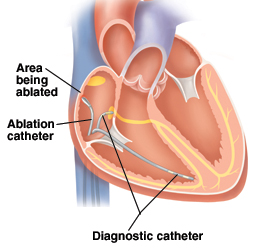Ablation - Catheter Treatment
Catheter Treatment - Ablation
 Catheter ablation is a non-surgical procedure done by an Electrophysiologist (EP doctor) to ablate (scar) part of an abnormal electrical pathway of the heart that is causing the heart rhythm problem. During these procedures, performed in a Cath Lab, the physician will insert several long, thin, flexible tubes with wires (called catheters) into your heart through blood vessels in your arm, upper thigh, or neck. In the heart, electrodes at the end of the catheter can help the doctor detect the faulty electrical sites.
Catheter ablation is a non-surgical procedure done by an Electrophysiologist (EP doctor) to ablate (scar) part of an abnormal electrical pathway of the heart that is causing the heart rhythm problem. During these procedures, performed in a Cath Lab, the physician will insert several long, thin, flexible tubes with wires (called catheters) into your heart through blood vessels in your arm, upper thigh, or neck. In the heart, electrodes at the end of the catheter can help the doctor detect the faulty electrical sites.
Hot or cold energy is then used to scar (ablate) these sites. Often, more than one ablation must be done to permanently cure atrial fibrillation. This treatment is generally used to treat paroxysmal AFib.
Types of Ablation
Atrial Fibrillation Ablation or Pulmonary Vein Isolation
The pulmonary veins are isolated with radiofrequency energy, creating a scar to help control AF more effectively than drugs alone.
Cryoablation
This newer, minimally invasive technology uses a catheter balloon inserted through the groin and guided to the heart. Once in place, the balloon is inflated, cooled, thus freezing tissue causing the irregular heartbeat and restores normal sinus rhythm.
AV Nodal Ablation
The AV (atrio -ventricular) node of the heart is permanently scarred to stop electrical signals from being transmitted from the upper chambers to the lower chambers of the heart. A permanent pacemaker is then implanted to control the heart's electrical system. This procedure is reserved for patients with difficult to control AFib.